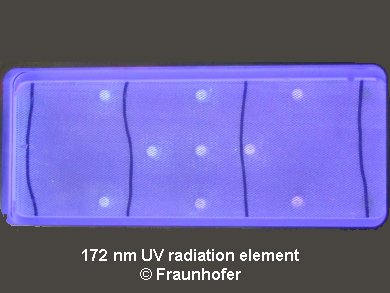Biological wastewater treatment plants cannot break down all harmfull substances found in wastewater. In particular, bacteria commonly employed in the biological treatment stage have no effect on persistent substances, which include highly stable hydrocarbon compounds. Therefore, cleaning agent residuals, pesticides, as well as pharmacological substances are reaching environmental waters.
Siegfried Egner and colleagues, Fraunhofer Institute for Interfacial Engineering and Biotechnology (IGB), Stuttgart, Germany, together with international industrial partners have developed a chemical reaction system that breaks down these molecules thoroughly and efficiently without having to add chemicals.
The team uses light sources that emit UV light exclusively in the region of 172 nm. As soon as these photons enter water, they split the H2O molecules, forming highly reactive hydroxyl radials. This process takes place only in the immediate vicinity of the UV emitter – a rectangular, flat glass element that is positioned in the reactor vessel. When power is applied to the element, the hydroxyl radicals form a thin reactive boundary layer of about 50 µm surrounding the external surface of the glass.
To be sure no harmful particles escape untreated, the water is controllably and verifiably directed through this boundary layer. The first industrial prototype has a throughput of 2.5 m²/h.
- Fraunhofer Gesellschaft, Munich, Germany
- IFAT in Munich, 5-9 May (Hall A5, Booth 219/318)




